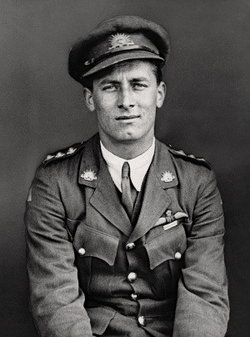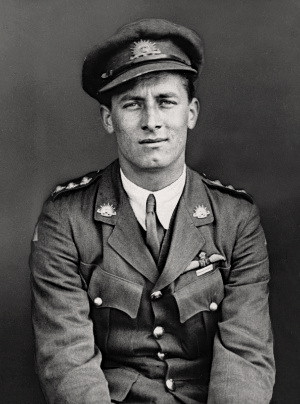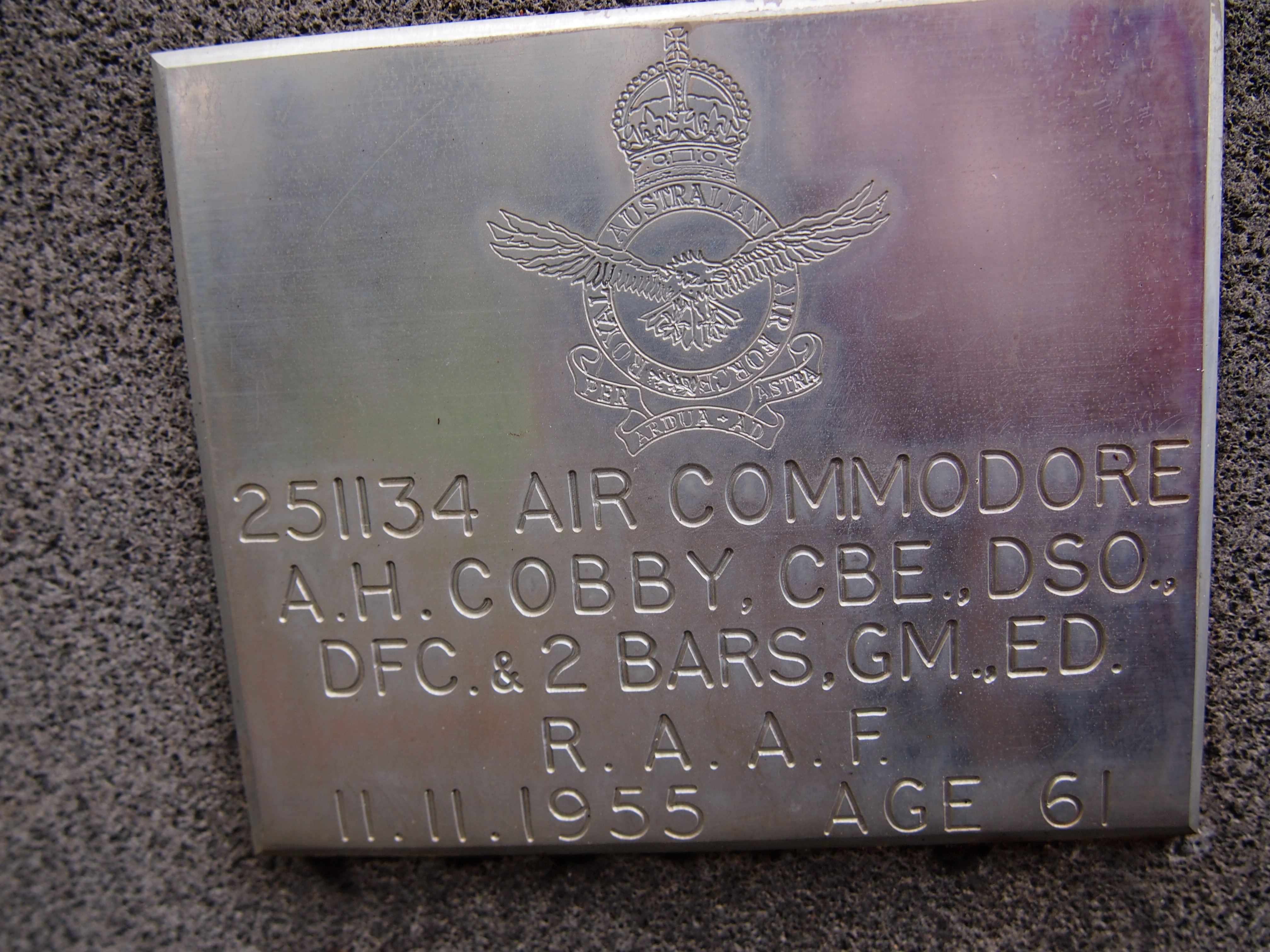He was discharged from the Air Force on 19 August 1946. He was awarded the American Medal of Freedom on 15 April 1948.
On Armistice Day Cobby collapsed in his Melbourne office and died later that day of hypertensive cerebrovascular disease at Heidelberg Repatriation General Hospital. He was given a military funeral at St. Mary's Church of England, Caulfied, and cremated at Springvale Crematorium.
Cobby Street in the Canberra suburb of Campbell is named in his honour.
Copy of extract from Fourth Supplement No. 30775 to the London Gazette dated 2nd July,1918
AWARDED THE DISTINGUISHED FLYING CROSS
"HIS MAJESTY THE KING has been graciously pleased to confer the Distinguished Flying Cross on the undermentioned Officer of the Royal Air Force in recognition of acts of gallantry and distinguished service:-
Lieutenant ARTHUR HENRY COBBY."
Copy of Extract from Second Supplement No. 30913 to the London Gazette dated 21st September, 1918.
AWARDED A BAR TO THE DISTINGUISHED FLYING CROSS
"HIS MAJESTY THE KING has been graciously pleased to confer a bar to the Distinguished Flying Cross on the undermentioned Officer of the Royal Air Force in recognition of gallantry in flying operations against the enemy:-
Lieutenant (temporary Captain) ARTHUR HENRY COBBY, D.F.C.
An Officer whose success as a leader is due not only to high courage and brilliant flying but salsa to the clear judgment and presence of mind he invariably displays. His example is of great value to other pilots in his squadron. During recent operations he shot down five machines in eleven days, accounting for two in one day."
AWARDED A SECOND BAR TO THE DISTINGUISHED FLYING CROSS
"One evening this Officer in company with another machine attacked five Pfaltz scouts, destroying two, one fell in flames and one broke up in the air. The Officer who accompanied him brought down a third machine out of control. While engaged in this combat they were attacked from above by five triplanes. Displaying cool judgment and brilliant flying Captain Cobby evaded this attack and returned to our lines in safety, both machines being undamaged. A determined and most skilful leader who has destroyed twenty one hostile machines or balloons, accounting for three machines and two balloons in four days."
Copy of Extract from Second Supplement No. 30989 to the London Gazette dated 2nd November 1918.
AWARDED THE DISTINGUISHED SERVICE ORDER
"HIS MAJESTY THE KING has been graciously pleased to confer the above award on the undermentioned Officer of the Royal Air Force in recognition of gallantry in Flying Operations against the Enemy:-
Lieutenant (temporary Captain) ARTHUR HENRY COBBY, D.F.C.
On the 16th August this Officer led an organised raid on an enemy aerodrome. At 200 feet altitude he obtained direct hits with his bombs and set on fire two hangars, he then opened fire on a machine which was standing out on the aerodrome. The machine caught fire. Afterwards he attacked with machine gun fire parties of troops and mechanics, inflicting a number of casualties. On the following day he led another important raid on an aerodrome, setting fire to two hangars and effectively bombing gun detachments, anti aircraft batteries, etc. The success of these two raids was largely due to the determined and skilful leadership of this Officer."
Copy of extract from Fifth Supplement No. 31089 to the London Gazette dated 27th December, 1918.
MENTIONED IN DESPATCHES
"The following is a continuation of SIR DOUGLS HAIG'S Despatch of the 8th November, 1918 submitting names deserving of special mention:-
Lieutenant (temporary Captain) A. H. COBBY, D.S.O., D.F.C.
He was discharged from the Air Force on 19 August 1946. He was awarded the American Medal of Freedom on 15 April 1948.
On Armistice Day Cobby collapsed in his Melbourne office and died later that day of hypertensive cerebrovascular disease at Heidelberg Repatriation General Hospital. He was given a military funeral at St. Mary's Church of England, Caulfied, and cremated at Springvale Crematorium.
Cobby Street in the Canberra suburb of Campbell is named in his honour.
Copy of extract from Fourth Supplement No. 30775 to the London Gazette dated 2nd July,1918
AWARDED THE DISTINGUISHED FLYING CROSS
"HIS MAJESTY THE KING has been graciously pleased to confer the Distinguished Flying Cross on the undermentioned Officer of the Royal Air Force in recognition of acts of gallantry and distinguished service:-
Lieutenant ARTHUR HENRY COBBY."
Copy of Extract from Second Supplement No. 30913 to the London Gazette dated 21st September, 1918.
AWARDED A BAR TO THE DISTINGUISHED FLYING CROSS
"HIS MAJESTY THE KING has been graciously pleased to confer a bar to the Distinguished Flying Cross on the undermentioned Officer of the Royal Air Force in recognition of gallantry in flying operations against the enemy:-
Lieutenant (temporary Captain) ARTHUR HENRY COBBY, D.F.C.
An Officer whose success as a leader is due not only to high courage and brilliant flying but salsa to the clear judgment and presence of mind he invariably displays. His example is of great value to other pilots in his squadron. During recent operations he shot down five machines in eleven days, accounting for two in one day."
AWARDED A SECOND BAR TO THE DISTINGUISHED FLYING CROSS
"One evening this Officer in company with another machine attacked five Pfaltz scouts, destroying two, one fell in flames and one broke up in the air. The Officer who accompanied him brought down a third machine out of control. While engaged in this combat they were attacked from above by five triplanes. Displaying cool judgment and brilliant flying Captain Cobby evaded this attack and returned to our lines in safety, both machines being undamaged. A determined and most skilful leader who has destroyed twenty one hostile machines or balloons, accounting for three machines and two balloons in four days."
Copy of Extract from Second Supplement No. 30989 to the London Gazette dated 2nd November 1918.
AWARDED THE DISTINGUISHED SERVICE ORDER
"HIS MAJESTY THE KING has been graciously pleased to confer the above award on the undermentioned Officer of the Royal Air Force in recognition of gallantry in Flying Operations against the Enemy:-
Lieutenant (temporary Captain) ARTHUR HENRY COBBY, D.F.C.
On the 16th August this Officer led an organised raid on an enemy aerodrome. At 200 feet altitude he obtained direct hits with his bombs and set on fire two hangars, he then opened fire on a machine which was standing out on the aerodrome. The machine caught fire. Afterwards he attacked with machine gun fire parties of troops and mechanics, inflicting a number of casualties. On the following day he led another important raid on an aerodrome, setting fire to two hangars and effectively bombing gun detachments, anti aircraft batteries, etc. The success of these two raids was largely due to the determined and skilful leadership of this Officer."
Copy of extract from Fifth Supplement No. 31089 to the London Gazette dated 27th December, 1918.
MENTIONED IN DESPATCHES
"The following is a continuation of SIR DOUGLS HAIG'S Despatch of the 8th November, 1918 submitting names deserving of special mention:-
Lieutenant (temporary Captain) A. H. COBBY, D.S.O., D.F.C.
Family Members
Sponsored by Ancestry
Advertisement
Advertisement





